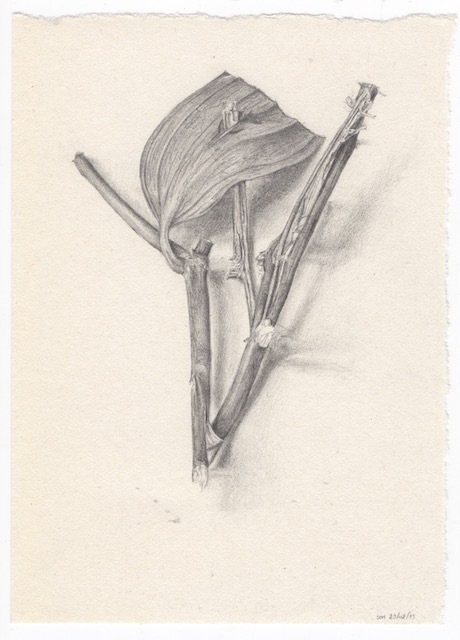23/02/2015
Sylvie De Meerleer
* 1986 in Bruges
Pencil on paper. Size of sheet: 14.8 x 10.5 cm.
Signed and dated.
€ 650.- + VAT
Invisible space
We feel another person’s emanation and understand each other through our energy fields. Every shape we perceive contains energy. These pulses are either getting us replete or exhausted. An energy field is an invisible space stripped of rigid limitations where vibrations are free to move from one spot to another. Sylvie De Meerleer makes energy fields tangible through her drawings. To her, shape is nothing but illusion, but the intangible and the beauty behind it do matter on the contrary. She’s looking for truth behind objects and every work of hers is a new attempt to getting closer to them. Her recent drawings announce that she no longer believes in shape and colour because we immerse ourselves too much in them and in doing so we lose sight of the core. Her drawings consisting of dots or lines merely suggest shapes. They appear to be austere, somewhat low-key images often dwelling in degrees of greyscales. The myriad of dots or lines insinuate stratification, texture and motion in the perception. In addition to this, the features of the drawing material, such as fat or dry graphite, determine the result. She also creates drawings using ink or marker entirely consisting of dots in one specific colour, but even there, the field or the coherence of unequal dots provide gradations within the overall entity.
Her images fluctuate. In certain places, traces agglomerate whereas elsewhere they grant each other space. It is a game of either attracting or repelling one another. De Meerleer avoids contour lines. It is pretty much like a cloud slipping along revealing only shades or a swarm of insects emerging due to the contrast between light- and darkness. To her, everything consists of degrees denoting presence and absence.
De Meerleer also makes series in which she uses pictures or copies to create her own images. Her generating possibilities are endless. She cuts up pictures into strips or patterns and rearranges them. This way, repetition and rhythm are providing new textures and sensitivities. Both the positive and the negative leftovers of the image, after cutting up, give way to a new composition. She also experiments with information from one sole image that she uses in another image and the effects of operations on materials. For instance, she quickly draws spontaneous lines on a photocopy, and then perforates the script in a controlled way with a puncture pen on a white sheet of paper under the photocopy. Wherever she pricks, traces of the ink on the photocopy remain on the white paper. In turn, the needle pricks provide pellets of texture on the medium. Here as well, various options are available. At times, she opts for the positive perception and at others for the negative one. The script achieves a turbulent and tense result where the outlines still can be felt. Sometimes she does not draw on the flip side, but only punctures fragments of the photocopy. It feels exactly as if layers with varying degrees between black and white were sliding over each other. The information on photocopies are but pixels moulding an image. By means of dots, De Meerleer shatters the illusion by which you perceive something as an image and a shape. The gap is crucial for her: nothing is connected.
Her images emerge from an area of tension between emptiness and presence. How much white space do you leave? What field-of-views do you offer the public? Where is the limit of the image? So, it often happens that she abandons her intended goal of filling a medium, leaving fragments in their unwrought state. She often sets off from a system of which she gradually frees herself, allowing thus coincidences to creep into her work. A new pen provides more ink and therefore leaves more dashing marks than an old one. A fresh choice of materials requires practice, which means that she will gradually handle them in a more meticulous way. The physical aspect is never far away. Each contact with her medium is powerful and energetic, yet recurrence and duration can induce a varying concentration, giving free rein to errors or deviations.
How can one influence perception through size and scale? De Meerleer works in both small and large sizes. Each drawing is approached in a meticulous and accurate way. Every work lacks a sense of scale. Is she pointing out a detail or zooming out on a larger picture? De Meerleer shows that experiencing space and time are only systems imposed on ourselves. They do offer structure and support, but to let them go for a while, offers a leeway putting their existence into perspective. While working, she focuses on every action as well as on the experience of the moment itself. The result shows the duration and intensity of her work. It is almost a kind of meditation during which she silently works for days while being very aware of her own presence. This alertness brings her closer to the truth. In this way, she converts the unshackled energy into script and texture on a medium. The remaining tracks are the remnants of a process during which she gives the best of herself with all of her body and mind. It is a physical challenge requiring perseverance to complete a work. Her satisfaction is contagious.
October 2018, Indra Devriendt (translated from Dutch into English by Marie-Charlotte Lauwereins)
